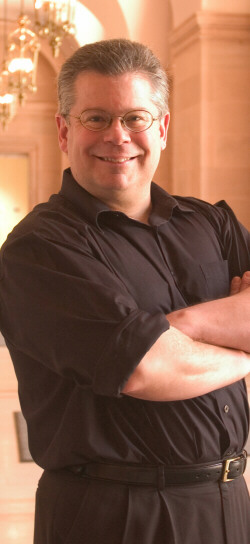Greenberg and the Alexander String Quartet explore Haydn and Carter
What could Franz Josef Haydn and Elliott Carter possibly have to say to each other across a 200-year divide? More than you might think, according to educator and composer Robert Greenberg, at a Saturday morning matinee in Herbst Theatre.
Standing alongside the Alexander String Quartet, long-time collaborators in the “Inspiration” series of lecture/concerts hosted by SF Performances, Greenberg was humorous, erudite and vital.
Describing Haydn as almost generic, the Kleenex of the classical quartet, he showed us the evolution of the “classical” style, a love affair with the clean lines and careful proportions of ancient Greece, which Haydn embodied in his own even-tempered personality and cemented with a prolific body of work.
In Haydn’s String Quartet in G major, Opus 76, No. 1, written shortly before his Oratorio, he sets up a careful balance between satisfying harmonies, intertwining counterpoint and the individual voices of the instruments. Greenberg used a Rousseau quote to explain the gentle converse of friends: “balancing individual freedom with social responsibility and accountability.”
After using much humor and short demonstrations from the quartet to ease our education—like, “That narcissistic first violin is saying, ‘Eat my shorts!’ ” and invoking Goldilocks for a sense of proportion—our lecturer turned the stage over to the Alexander Quartet, which was in top form for an audience illuminated by the inner workings of the piece.
In the second half of the program they turned to Elliott Carter’s String Quartet No. 2, written in 1959 in nine overlapping movements at the heady swell of American modernism. Having abandoned both Stravinsky’s neoclassicism and the populism of Copland and Ives, Carter returned to a pure modernism which, though highly structured, frankly questioned all aspects of the music.
His approach to a string quartet was to let each instrument express itself as only it can, replete with private tempos. Greenberg described the first violin as ornate and whimsical; the second, orderly with humorous pizzicato. The cello is grumpy, deep and abrupt, and the viola, most soulful. These strata play with and against one another, an interaction that is filled with the disquiet of a playwright whose actors have taken leave of their lines and rebelled.
In a lovely coda, Greenberg demonstrated how this anarchic ride is a true heir to Haydn, a demonstration of “democratic ideals: the will of different individuals to work together.”
And then the music—just glorious.
The cello opened with descending fourths, and a chord over which a violin gestured. The viola picked up the threads, rising with its own language of augmented fourths resolving to fourths. The introduction presented the themes of each instrument, and the following movements flowed into cadenzas developing each voice.
Zakarias Grafilo, first violin, treaded between a soft private language and high brilliant splashes of notes: he was inspired in the cadenza. Frederick Lifsitz supported and chivied the troops with long bowed notes, pizzicatos and sudden short strokes. Cellist Sandy Wilson filled Herbst with powerful lows and large dissonant intervals. And Paul Yarborough’s viola sang the moving heart of the piece.
Awarded a Pulitzer Prize, Carter’s Quartet contains a disjoint density that invokes cubism: sketched-in motifs, blocks of color, harsh edges, and brilliantly faceted views of its elements.
The next “Inspirations” concert, Saturday, March 15, at 10 am, joins Bartók with a string quartet Robert Greenberg wrote for the Alexander Quartet. See www.performances.org for more information.
—Adam Broner
This article originally appeared in the Piedmont Post
